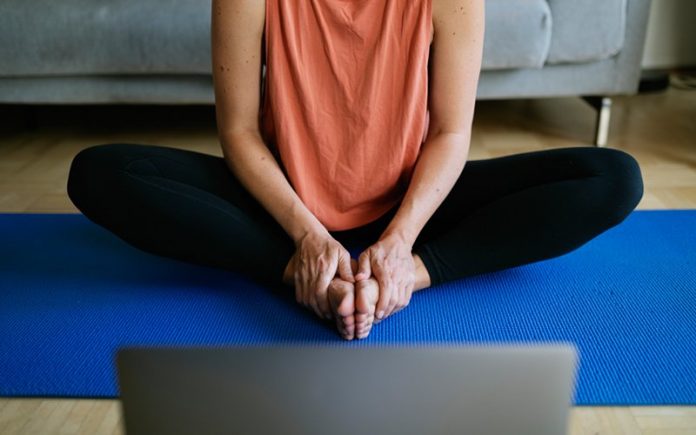
PARIS: Who would have thought it? French people have overwhelmingly switched to exercising at home. What appeared to be a constraint during the first lockdowns is here to stay.
After all, these classes that we can take whenever we want, without having to run to the gym, are responding to a profound change in our lifestyles.
From now on, there will be no more opening and closing hours, no more dress codes, no more collective rhythms, but instead a 24/7 product with activities on-demand.
Muriel, 45 years old, has been addicted to virtual workout classes since the first lockdown this spring: “My two yoga teachers immediately set up virtual sessions and it was a real ‘aha’ moment for me.
No need to rush to get there on time, no need to lug yoga mats and bricks around or to change in the locker room. In two minutes, I unroll my mat and away we go.”
Like Muriel, 29% of French people have switched up their living spaces since March 2020 in order to create a workout or relaxation area*.
Like her, 43% of French individuals have done some physical activity during the lockdown period, 29% of them online.
And, according to surveys, like her, 14% to 29% of them intend to continue participating in digital fitness, even after sports facilities reopen**.
There’s no doubt that when it comes to sports and fitness, next year will be more connected than ever.
In the span of just a few months and amidst lockdown restrictions, the landscape of online fitness has expanded exponentially.
It’s hard to find a coach, dance teacher, fitness studio or sports club today that doesn’t offer those at home the chance to work up a sweat at a distance. On the website of France’s ministry of sports, one can even find a top-30 list of applications and websites to help people “exercise at home remotely.”
However, until very recently, in France, very few professionals in the sector were seriously investing in digital fitness, says Mickael Pinto, executive director of Neoness Live*** : “Before the health crisis, we talked a bit about online fitness but we never received any signals that would have made us invest heavily in this area.”
This blasé attitude would be shattered with the first lockdown: “We immediately set up free online courses on Facebook and Instagram to maintain a connection with our members, and the response blew us away. We didn’t expect such a massive success.”
When the initial moment of panic, followed by “quick, find a solution on social media,” had passed, the group began working on creating a more professional, paid and long-term model. “The free model was not viable for us, all our coaches are on long-term contracts.”
The chain came up with the idea of transforming one of their Paris fitness club locations into a TV studio.
“We invested hundreds of thousands of euros, set up a real control room, lights, cameras, we trained the teachers in virtual coaching to teach them how to speak facing the camera, with a smile and as if there were people in front of them.
“When we reopen, we’ll use the space once again [for members], but we’ll still film some of the courses for our online members in the same room.”
Going digital has become a point of no return for professionals and practitioners, as well as a new opportunity for the sector to attract clients other than those already accustomed to going to the venues: “The audience is different from our usual members, much larger in number, more females, a little older (37 years old on average), inclined towards wellness activities such as yoga, dance and Pilates,” confirms Pinto.
“It also includes people who, since the lockdown and thanks to digital technology, have picked up a physical routine because it’s easy, practical and also cheaper.”
Half the price on average of physically going to the gym. That was a key factor in convincing Marie, a 25-year-old student, to subscribe to the platform during the first lockdown: “120 euros per year for 50 options of live classes per week, and replays available so I can practice whenever I want – it’s perfect for me,” she explains.
The digitalisation of fitness also means being able to go beyond borders, with access to teachers, places or courses that were previously inaccessible.
Marie, for example, happily followed Caribbean dance classes with a Jamaican star live from Kingston. Julie, 41 years old, swayed on her Parisian terrace during one hour of “Dirty Dancing” live “from New York.”
“It was completely crazy, there were about 20 of us girls from all over the world having a blast.” Meanwhile, 38-year-old Christelle lived out a childhood fantasy by enrolling in a series of ballet classes taught by Dorothée Gilbert, principal dancer at the Paris Opera.
“When I was little, I dreamed of being a ballerina, but I wasn’t built to be a professional dancer,” says Christelle.
Thirty years later, she feels she’s getting her own back: “I have no complex about taking classical lessons given by a star dancer from the Opera, and no one is there to tell me I don’t look like I have the physique for the job.”
No hangups: digital is indeed an effective tool to get the shy and body-conscious onboard.
“Many new members tell us that remote fitness removes a barrier,” says Pinto. “They go outside their comfort zones!” Muriel, our neo-yogi in her 40s, agrees: “In the studio, I wasn’t necessarily very comfortable in front of the others: I can’t do all the positions for health reasons and I was afraid of being seen as the old lady or the resident slowpoke of the class.”
Since then, her confidence has increased, and little by little she has tried other disciplines online: “Pilates, muscle strengthening… I realised that I was able to do a lot of things (like push-ups and squats) that I would never have thought of or dared to do, thinking that it wasn’t for me.”
It’s precisely to free people from such self-imposed restrictions relating to the practice of yoga that Marion Cas, founder of Yogily Yours, created her platform of personalized online classes (though she also offers customized coaching at home): “For some people, just taking the step of putting on leggings is an ordeal!” she says.
“In yoga, you have to reveal your body somewhat, do poses where your buttocks are up in the air, breathe hard… and many people find it difficult to do this in real life.”
Not to mention the spiritual or “even slightly esoteric” aspect of the discipline which can disconcert newcomers: “The ohm, namaste, the mantras — in a group, that can put some people off. At least online, people remain in full control of what they want to do at any given moment.”
Even taking a break: “If it’s too hard, I just stop by cutting the camera off, no guilt,” Muriel notes. Something that in real life, under the coach’s watchful eye, is almost impossible.
Of course, there are inconveniences to working out alone in your room. The lack of human connection, of the opportunity to receive feedback or corrections from the teacher, “but they take time before and after the course to speak with each participant,” Muriel outlines.
Neoness Live offers a 30-minute chat after each class, in the form of a question-and-answer session, to create a personal connection.
“It also allows us to better guide people towards a practice or a level that will suit them,” explains Souleymane, an HIIT coach, who estimates that online practice is appropriate for 95% of people.
“The remaining 5% are people who have real health problems that we wouldn’t be able to detect, such as hernias.”
But to work out effectively alone, and without any physical problems, you still need to know how to correctly evaluate yourself in order to avoid injury or physical “burn-out”.
Marie, 25 years old, a Neoness Live subscriber, learned this the hard way: “During the first lockdown, I wanted to try everything, from dancing to intense cardio …”.
Sometimes up to 5 hours a day in Netflix zapping mode. One injury later, she learned to focus on what’s right for her: “Now I know where I stand and I know how to self-evaluate.”
Will she continue online classes when the gyms reopen? Of course, she laughs: “Without the lockdown and the online classes, I would never have learned how to twerk.” And that’s something that rivals the value of any in-person coach in the world.
* “Aux confins du logement” survey on experiences of housing under lockdown by the Institut des Hautes Etudes pour l’Action dans le Logement (IHEAL)
** Sports and Health Barometer by the Fédération Française d’Éducation Physique et de Gymnastique Volontaire and Ipsos, carried out in September 2020
*** Multi-sport fitness hub, launched last September


